Bromley, Roger Arthur (Flight Lieutenant)
Killed in Action 1944-June-18
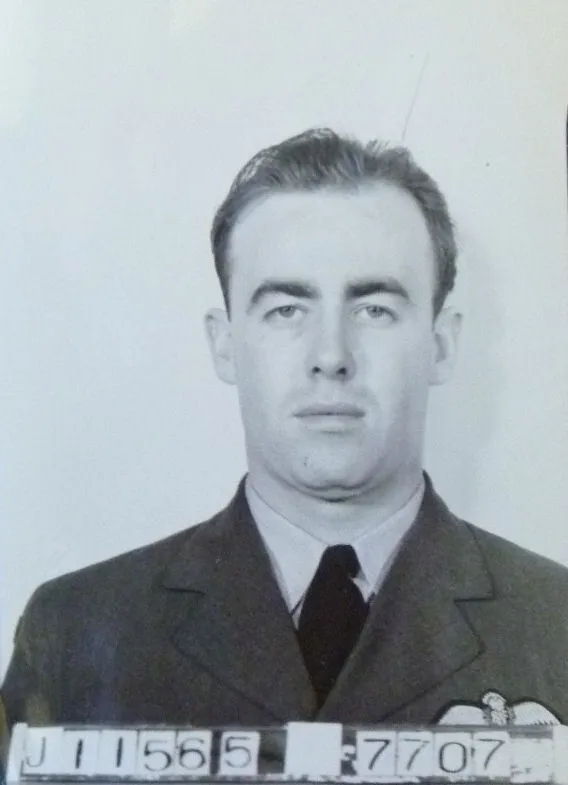

Birth Date: 1923
Born:
Parents:
Spouse:
Home: St Catharines, Ontario
Enlistment:
Enlistment Date: unkown date
Service
RCAF
Unit
414 Sqn- Squadron
Totis Viribus With All our Might
Base
RAF Dunsfold
Rank
Flight Lieutenant
Position
Pilot
Service Numbers
J/11565
Mustang serial: AM251
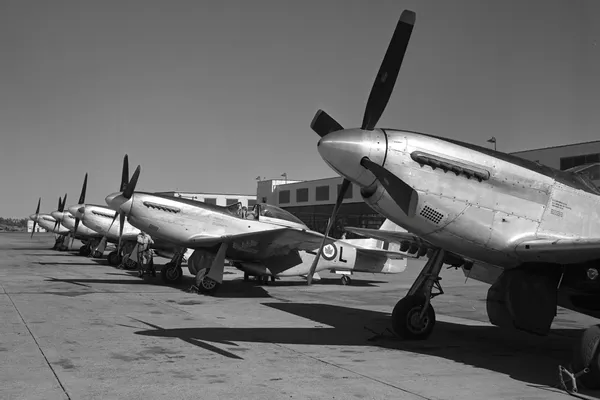
North American Mustang Mk. IV, RCAF (Serial No. 9253), coded BA-S,
No. 424 Squadron, Hamilton, Ontario
Chris Charland noted that the Mustang in the forefront is former USAF P-51D (Serial No. 44-74502A).
The North American Aviation P-51 Mustang is an American long-range, single-seat fighter and fighter-bomber used during World War II and the Korean War, among other conflicts. The Mustang was designed in April 1940 by a team headed by James Kindelberger of North American Aviation (NAA) in response to a requirement of the British Purchasing Commission. The Purchasing Commission approached North American Aviation to build Curtiss P-40 fighters under license for the Royal Air Force (RAF). Rather than build an old design from another company, North American Aviation proposed the design and production of a more modern fighter. The prototype NA-73X airframe was rolled out on 9 September 1940, 102 days after the contract was signed, and first flew on 26 October
The Mustang was designed to use the Allison V-1710 engine, which had limited high-altitude performance in its earlier variants. The aircraft was first flown operationally by the RAF as a tactical-reconnaissance aircraft and fighter-bomber (Mustang Mk I). Replacing the Allison with a Rolls-Royce Merlin resulted in the P-51B/C (Mustang Mk III) model, and transformed the aircraft's performance at altitudes above 15,000 ft (4,600 m) (without sacrificing range), allowing it to compete with the Luftwaffe's fighters. The definitive version, the P-51D, was powered by the Packard V-1650-7, a license-built version of the two-speed, two-stage-supercharged Merlin 66, and was armed with six .50 caliber (12.7 mm) AN/M2 Browning machine guns.
Canada had five squadrons equipped with Mustangs during the Second World War. RCAF Nos. 400, 414 and 430 Squadrons flew Mustang Mk. Is (1942"“1944) and Nos. 441 and 442 Squadrons flew Mustang Mk. IIIs and Mk. IVAs in 1945. Wikipedia and Harold Skaarup web page
Unit Desciption
414 Sqn Totis Viribus ("Sarnia Imperials")
History of the Squadron during World War II (Aircraft: Lysander III, Tomahawk I & II, Mustang I, Spitfire X)
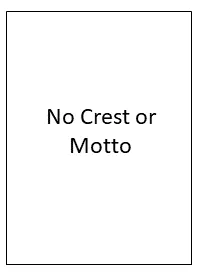
Note that during WWII the squadron had no crest nor motto. These were awarded later. The squadron was unofficially known as the “Sarnia Imperialsâ€.
No. 414 Squadron was formed as the RCAF's 12th squadron formed overseas in WWII, at Croydon, Surrey, UK ![]() . It was the second Army Co-operation unit to be formed in this group, and was initiated on 13 August 1941. In the early days, it flew Westland Lysander Mk. III aircraft before flying Curtiss Tomahawk Mks. I and II (both non-operationally). It saw no action in the AC role since no army units were active in Europe. On 28 June 1943 the unit was re-designated a Fighter Reconnaissance unit at Dunsfold, Surrey. Thereafter, the squadron joined the 2nd Tactical Air Force. By now it was flying North American Mustang Mk. I aircraft. The duties were to provide intelligence, such as photographic reconnaissance before and after D-Day, and tactical reconnaissance once the invasion had taken hold. The squadron was issued with Supermarine Spitfire aircraft and moved to France in August 1944, and thereafter followed the Allied armies in their progress through France, the Low Countries and Germany, providing reconnaissance for them. The squadron was disbanded at Luneburg, Germany
. It was the second Army Co-operation unit to be formed in this group, and was initiated on 13 August 1941. In the early days, it flew Westland Lysander Mk. III aircraft before flying Curtiss Tomahawk Mks. I and II (both non-operationally). It saw no action in the AC role since no army units were active in Europe. On 28 June 1943 the unit was re-designated a Fighter Reconnaissance unit at Dunsfold, Surrey. Thereafter, the squadron joined the 2nd Tactical Air Force. By now it was flying North American Mustang Mk. I aircraft. The duties were to provide intelligence, such as photographic reconnaissance before and after D-Day, and tactical reconnaissance once the invasion had taken hold. The squadron was issued with Supermarine Spitfire aircraft and moved to France in August 1944, and thereafter followed the Allied armies in their progress through France, the Low Countries and Germany, providing reconnaissance for them. The squadron was disbanded at Luneburg, Germany ![]() on August 7, 1945.
on August 7, 1945.
In the course of WWII the squadron flew over 6,000 sorties for the loss of 23 pilots, 19 of whom were killed or missing, the remaining 4 being POWs. They claimed 29 enemy aircraft destroyed, 1 probable and 11 damaged. On ground attack, they accounted for 76 locomotives and other miscellaneous targets. The squadron produced one ace, Flight Lieutenant D.I. Hall DFC. Awards gained were 2 Bars to DFC, 16 DFCs and 3 MiD. Battle Honours were:Defence of Britain 1942-43, Fortress Europe 1942-44, Dieppe, France and Germany 1944-45: Normandy 1944, Arnhem Rhine, Biscay 1943Wikipedia, Kostenuk and Griffin
Maps for Movements of 414 Squadron 1941-45
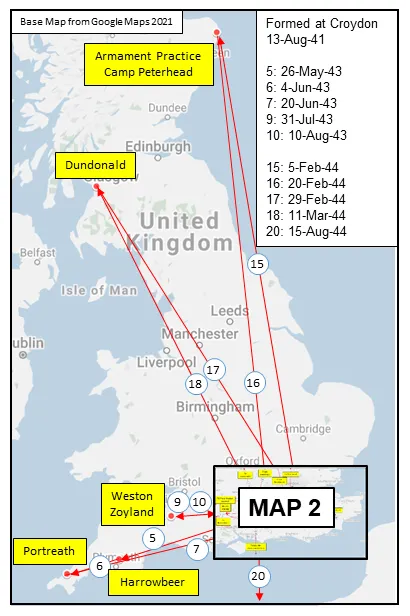
MAP 1: 414 Squadron Movements in Britain 1941-44 (right-click on image to display enlarged in new tab)
|
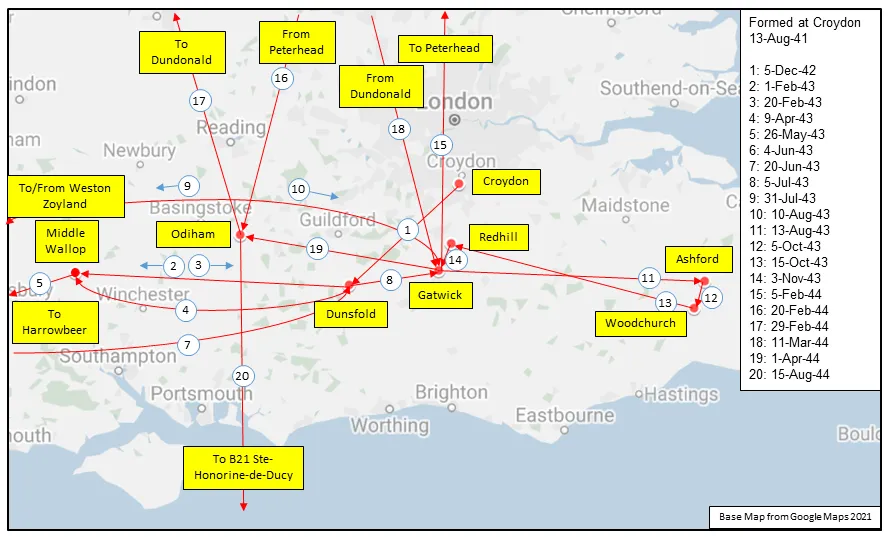
MAP 2: 414 Squadron Movements Detail of Map 1
|
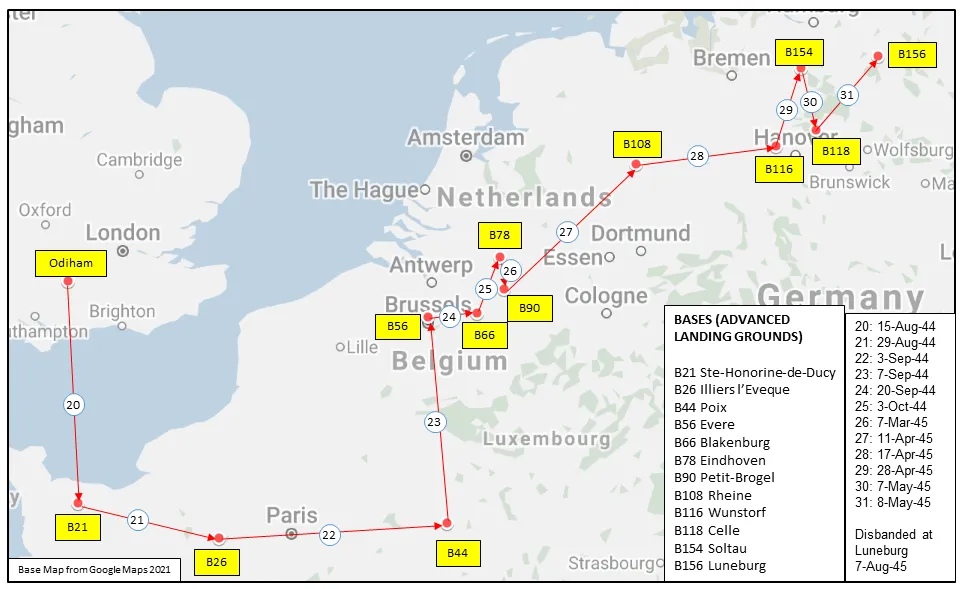
414 Squadron History Summary 1941-45
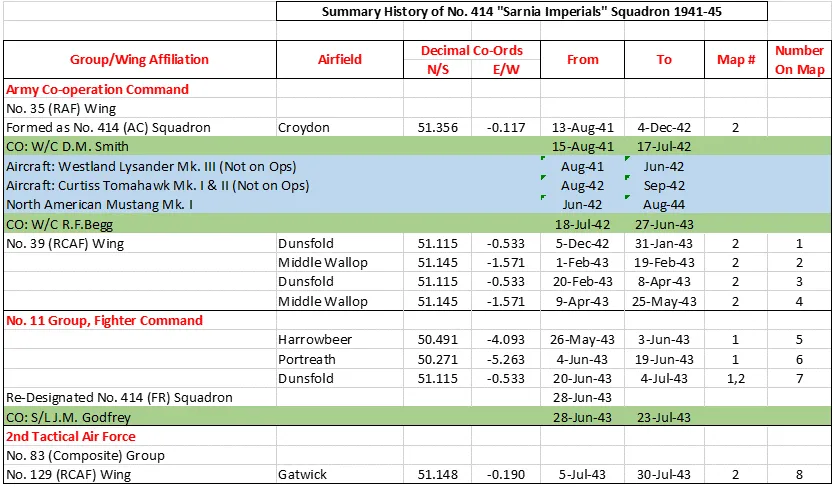
414 Squadron History Summary 1941-45 Page 2
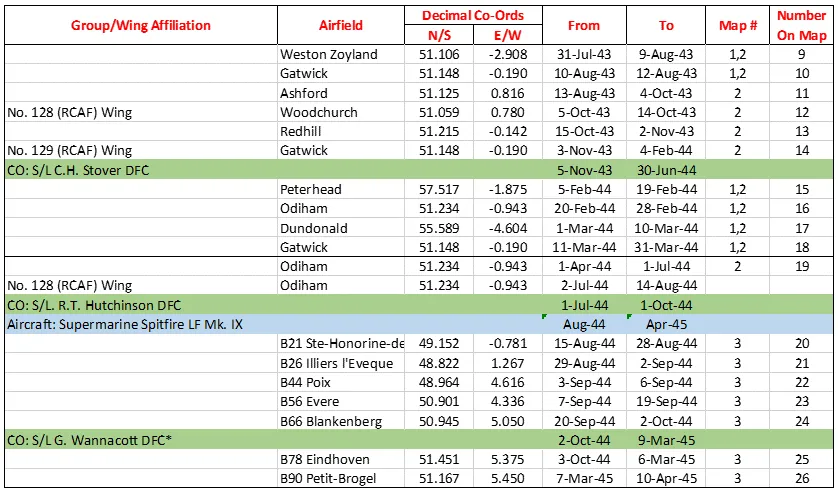
414 Squadron History Summary 1941-45 Page 3

History of the Squadron Post-WWII (Aircraft: Dakota IIIP & IVP, Sabre 4, 5, 6, Canuck, Voodoo, Silver Star)
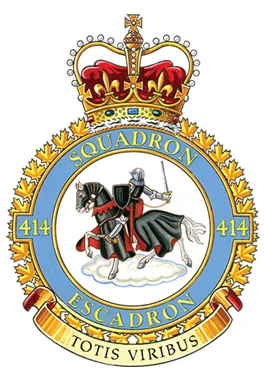
Unofficially, No. 14 (Photographic) Squadron at Rockcliffe (Ottawa), Ontario ![]() was formed on 12 June 1944, and it was officially renumbered No. 414 on 1 April 1947. The squadron flew Douglas Dakota IIP and IVP aircraft on vertical photographic duty, to photograph 323,754 square miles (838,520 km2) of Canada's North. When this task was completed the squadron was disbanded on 1 November 1950.
was formed on 12 June 1944, and it was officially renumbered No. 414 on 1 April 1947. The squadron flew Douglas Dakota IIP and IVP aircraft on vertical photographic duty, to photograph 323,754 square miles (838,520 km2) of Canada's North. When this task was completed the squadron was disbanded on 1 November 1950.
The squadron was re-formed as a Fighter unit at Bagotville, Quebec ![]() on 1 November 1952, equipped with Canadair Sabre aircraft. It later joined No. 4 (Fighter) Wing at Baden-Soellingen, Germany
on 1 November 1952, equipped with Canadair Sabre aircraft. It later joined No. 4 (Fighter) Wing at Baden-Soellingen, Germany ![]() in August 1953. In 1956, it was decided to replace one Sabre squadron in each of No. 1 Air Division Europe’s four wings with an all-weather fighter unit. When No. 419 AW(F) Squadron arrived from Canada, No. 414 was deactivated on 14 July 1957 and reactivated as All-Weather (Fighter) at North Bay, Ontario
in August 1953. In 1956, it was decided to replace one Sabre squadron in each of No. 1 Air Division Europe’s four wings with an all-weather fighter unit. When No. 419 AW(F) Squadron arrived from Canada, No. 414 was deactivated on 14 July 1957 and reactivated as All-Weather (Fighter) at North Bay, Ontario ![]() on 5 August 1957. The squadron flew CF-100 and CF-101 aircraft on North American air defence until disbanded on 30 June 1964.
on 5 August 1957. The squadron flew CF-100 and CF-101 aircraft on North American air defence until disbanded on 30 June 1964.
The squadron re-formed once again at RCAF Station St-Hubert, Quebec ![]() , on September 15, 1967 as 414 Electronic Warfare Squadron, with CF-100 aircraft. The unit provided Air Defence Command ground control radar personnel and airborne interceptor crews with training and experiences in combating radar jamming. On 1 February 1968 the squadron was integrated into the Canadian Armed Forces. In August 1972, 414 moved to Canadian Forces Base North Bay and stayed there until 1992, when they were split in two with one part going to Canadian Forces Base Comox, British Columbia
, on September 15, 1967 as 414 Electronic Warfare Squadron, with CF-100 aircraft. The unit provided Air Defence Command ground control radar personnel and airborne interceptor crews with training and experiences in combating radar jamming. On 1 February 1968 the squadron was integrated into the Canadian Armed Forces. In August 1972, 414 moved to Canadian Forces Base North Bay and stayed there until 1992, when they were split in two with one part going to Canadian Forces Base Comox, British Columbia ![]() as 414 Composite Squadron and the other part going to Canadian Forces Base Shearwater, Nova Scotia as 434 Composite Squadron. 414 changed its name to Combat Support Squadron in 1993 when it was equipped with the CT-133 Silver Star. In 2002, 414 Squadron was disbanded and its remaining two aircraft retired.
as 414 Composite Squadron and the other part going to Canadian Forces Base Shearwater, Nova Scotia as 434 Composite Squadron. 414 changed its name to Combat Support Squadron in 1993 when it was equipped with the CT-133 Silver Star. In 2002, 414 Squadron was disbanded and its remaining two aircraft retired.
On 7 December 2007 approval was received for the squadron to stand up once more, this time as 414 EWS (Electronic Warfare Support) Squadron. Belonging to the RCAF Aerospace Warfare Centre, the squadron is based in Ottawa and is composed of military Electronic Warfare Officers who fulfill the combat support role, flying on civilian contracted aircraft.